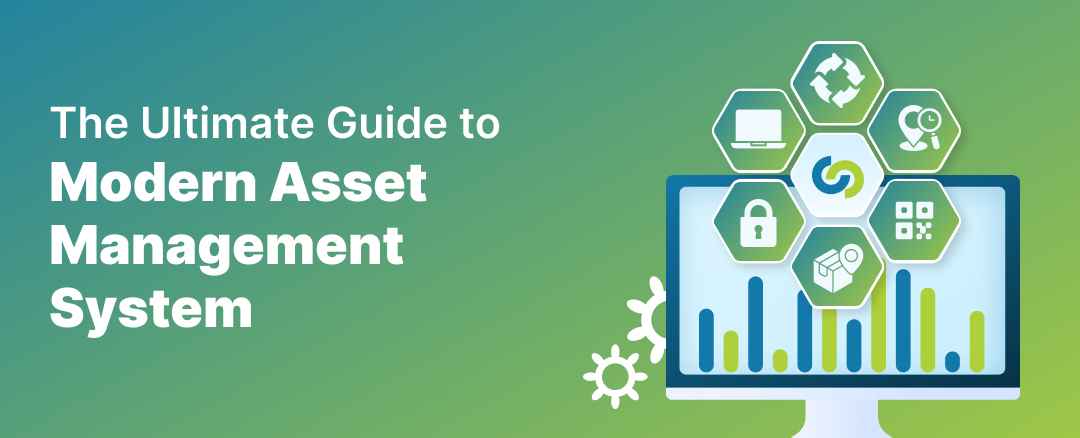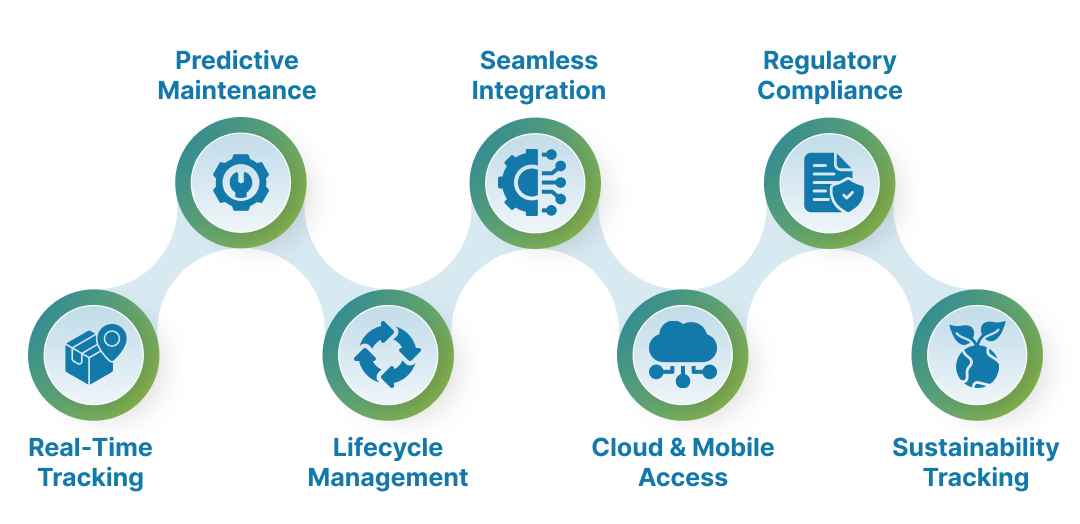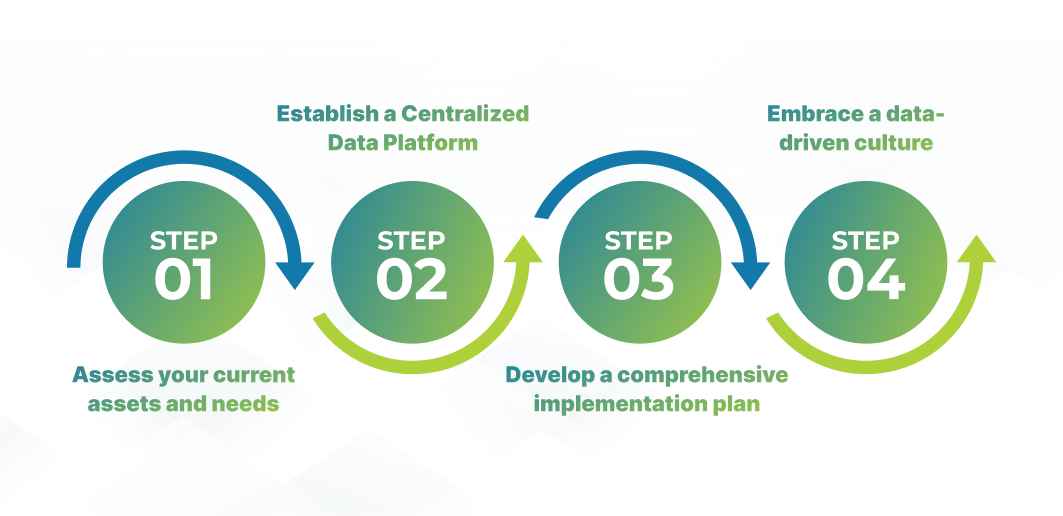
Table of Contents
ToggleThe Ultimate Guide to Modern Asset Management for Growing Businesses
Strategic growth requires a modern approach to managing your assets. Does your current system support this vision or hold you back because of poor asset management? This guide shows how smart systems can turn assets from a liability into a key growth driver. We’ll explore modern asset management, the essential features, and the many advantages they bring to your business operations.
Modern asset management is about more than just tracking items. It’s an integrated strategy to maximize value throughout an asset’s lifecycle. You need real-time data to make smart decisions and stay agile. Without a unified system, you risk costly errors and a lack of clear visibility. This guide helps you move from reactive maintenance to a proactive, data-driven strategy.
Key takeaways
- Modern asset management goes beyond simple tracking. It involves a strategic, data-driven approach to optimize the entire lifecycle of assets.
- Implementing a unified software solution offers significant benefits. These include increased efficiency and reduced operational costs.
- Modern systems provide critical features. These features are predictive maintenance, real-time tracking, and seamless integration with other systems.
- A proactive approach helps businesses avoid costly breakdowns. It also allows them to make smarter decisions and better allocate resources.
What's an asset?
An asset is anything a company owns that holds economic value. Businesses expect this value to provide future benefits. It can be a tangible item or an intangible resource. Both are crucial for operations and overall profitability.
Examples include physical machinery, vehicles, and office furniture. Intangible assets are often software licenses or intellectual property.
What is asset management?
Asset management is the systematic process of deploying, operating, maintaining, and upgrading assets. The goal is to maximize their value and minimize their costs. It ensures assets provide the greatest return on investment for the company. Effective management aligns asset use with the company’s strategic objectives.
What assets do modern businesses typically manage?
Businesses manage a wide variety of assets. These assets range from physical to digital. Tangible assets include vehicles, machinery, and office equipment. Digital assets cover software licenses, IT hardware, and data storage systems. Businesses also manage infrastructure like servers, networks, and communication systems. The key is to manage all these items within a unified framework.
What is IT service management (ITSM)?
IT Service Management (ITSM) focuses on the delivery, operation, and support of IT services. It ensures IT services meet the needs of the business. ITSM is closely linked to IT asset management. ITAM focuses on the hardware and software lifecycle. ITSM is about managing the service delivery surrounding those assets. The two disciplines work together for optimal performance and efficiency.
Take Control of Your Business Data
Unified platform can help you manage and scale your business.
- Centralized Management
- Improved Data Quality
- Future-Proof Your Business
7 features of modern asset management systems
Modern asset management systems like Integrow provide a suite of advanced features. These features empower businesses to gain control and visibility. They enable proactive management and smarter decision-making. The right system offers a unified platform to manage all your assets.
- Integrated asset tracking
Integrated asset tracking uses advanced technology for real-time visibility. It often incorporates IoT sensors, RFID tags, and QR codes. This provides accurate location data and usage metrics. You can instantly see where an asset is and who is using it. This real-time tracking reduces loss and helps with efficient asset allocation.
- Maintenance scheduling and management (with predictive analytics and automation)
Predictive maintenance uses data to forecast potential equipment failures. It analyzes sensor data to detect early signs of wear and tear. This allows businesses to schedule maintenance proactively. Automation triggers work orders based on these predictions. This approach minimizes downtime and prevents costly, unexpected repairs.
- Asset lifecycle management
Asset lifecycle management provides a holistic view from acquisition to disposal. This process helps you track costs and make informed replacement decisions, ensuring you get maximum value from each asset.
- Integration with enterprise business systems
A modern system integrates seamlessly with your ERP, CRM, and accounting systems. This creates a unified data environment, eliminating silos and providing a single source of truth for all your asset information.
- Cloud-based infrastructure and mobile accessibility
Cloud-based systems offer unparalleled flexibility and accessibility. Users can access asset data from anywhere, on any device. Mobile apps allow field technicians to update records in real-time. This provides up-to-the-minute data and eliminates the need for manual data entry.
- Regulatory compliance and advanced security
Modern systems help businesses meet strict regulatory requirements. They maintain detailed audit trails and provide compliance reporting. These features ensure you follow industry standards while advanced security protects sensitive data, preventing breaches.
- Sustainability and environmental compliance tracking
Sustainability is now a critical business concern. Modern systems help you track an asset’s environmental impact. They monitor energy consumption and waste generation. This data helps you optimize operations for sustainability. It ensures compliance with environmental regulations.

4 asset management principles are:
- Lifecycle Management: This is about managing an asset’s entire life. It starts with planning and purchase. It continues through its operation, maintenance, and eventual disposal. The goal is to maximize the asset’s value at every stage.
- Risk Management: This principle identifies risks related to your assets. It focuses on mitigating these risks. This ensures business continuity and protects your company’s reputation.
- Performance Optimization: This involves continuous monitoring and analysis. You use data to track an asset’s performance. This allows for informed decisions about its maintenance and use.
- Value Realization: All asset management activities should create value. They must align with your business goals. The aim is to deliver a clear return, like improved service or profitability.
Advantages of implementing asset management software
Implementing a unified asset management solution improves operations and strengthens your financial position. The right software is a strategic investment that delivers tangible returns.
Increased productivity and cost savings
Automating asset tasks boosts productivity, freeing employees for strategic work. By automating manual tasks, some companies have seen maintenance staff productivity increase by up to 55%.
Reduced risk of errors and improved compliance
An automated asset management system ensures data accuracy, with up to 99.9% accuracy, reducing the risk of costly mistakes and non-compliance fines. Its built-in audit trails simplify compliance reporting, providing a clear record of all activities.
Streamlined decision making and financial operations
Real-time data gives you an accurate picture of your assets, enabling smarter investment and resource allocation. This visibility streamlines financial operations by optimizing asset use and controlling expenses.
4 steps to smarter asset management
Assess your current assets and needs
Conduct a comprehensive audit of all your physical and digital assets. Identify key pain points and determine what you need in a new system.
Choose the right software
Select a solution that offers a wide range of features. Look for a system with integrated tracking, predictive analytics, and enterprise system integration.
Develop a comprehensive implementation plan
Create a detailed plan for rollout. This includes data migration, employee training, and a phased deployment.
Embrace a data-driven culture
Use the insights from your new system to make smarter decisions. Encourage all teams to rely on the data to optimize their operations and improve efficiency.

Best Practices for Business Excellence
Adopting a strategic mindset toward asset management is crucial. It’s about leveraging technology to create efficiency. It also means building a culture of responsibility and continuous improvement.
Creating a Strategic Asset Inventory Foundation
A complete, accurate asset inventory is your foundation. Using unique identifiers like barcodes or RFID tags ensures every asset is tracked, preventing loss and improving financial reporting.
Building Dynamic Asset Management Strategies
Develop strategies that adapt to business changes. Your plan should be flexible and responsive. Use real-time data to adjust maintenance schedules and resource allocation. A dynamic strategy helps you stay ahead of potential issues. It keeps your operations running smoothly.
Maximizing Portfolio Performance Through Data-Driven Decisions
Use data to analyze asset performance. Identify assets that are underutilized or costing too much to maintain. This insight helps you make informed decisions about replacements. Data-driven decisions ensure that your asset portfolio is always optimized for maximum return.
Mastering Preventive Maintenance Excellence
Shift your focus from reactive to preventive maintenance. Schedule maintenance based on an asset’s usage and condition. This approach reduces the likelihood of unexpected breakdowns. It extends the lifespan of your equipment. It also lowers long-term repair costs.
Making Assets Work Smarter Through Technology
Embrace technologies like IoT and AI to enhance asset management. IoT sensors provide real-time data on an asset’s condition. AI analyzes this data to predict future issues. This technology helps you automate tasks. It allows assets to provide valuable, actionable intelligence.
Cultivating Asset Management Excellence Across Organizations
You must Create a culture where everyone values and respects assets. Provide training to employees on proper asset handling and reporting. Encourage cross-functional collaboration. This holistic approach ensures that asset management is not just an IT or operations function. It becomes a shared organizational priority.
Asset management glossary:
- Asset Lifecycle Management (ALM): Managing an asset from its initial request to its final disposal.
- Capital Asset: A long-term asset not consumed or sold in the normal course of business.
- IT Asset Management (ITAM): A business practice that manages all of an organization’s IT assets.
- Predictive Maintenance: Using data and analytics to predict when an asset will fail.
- Total Cost of Ownership (TCO): All direct and indirect costs associated with an asset.
- Service Level Agreement (SLA): A contract outlining the level of service expected from a vendor.
Secure Your Spot Before It’s Gone
Only 6 companies per industry will shape what comes next.
Be one of them and lead the change, not chase it.


